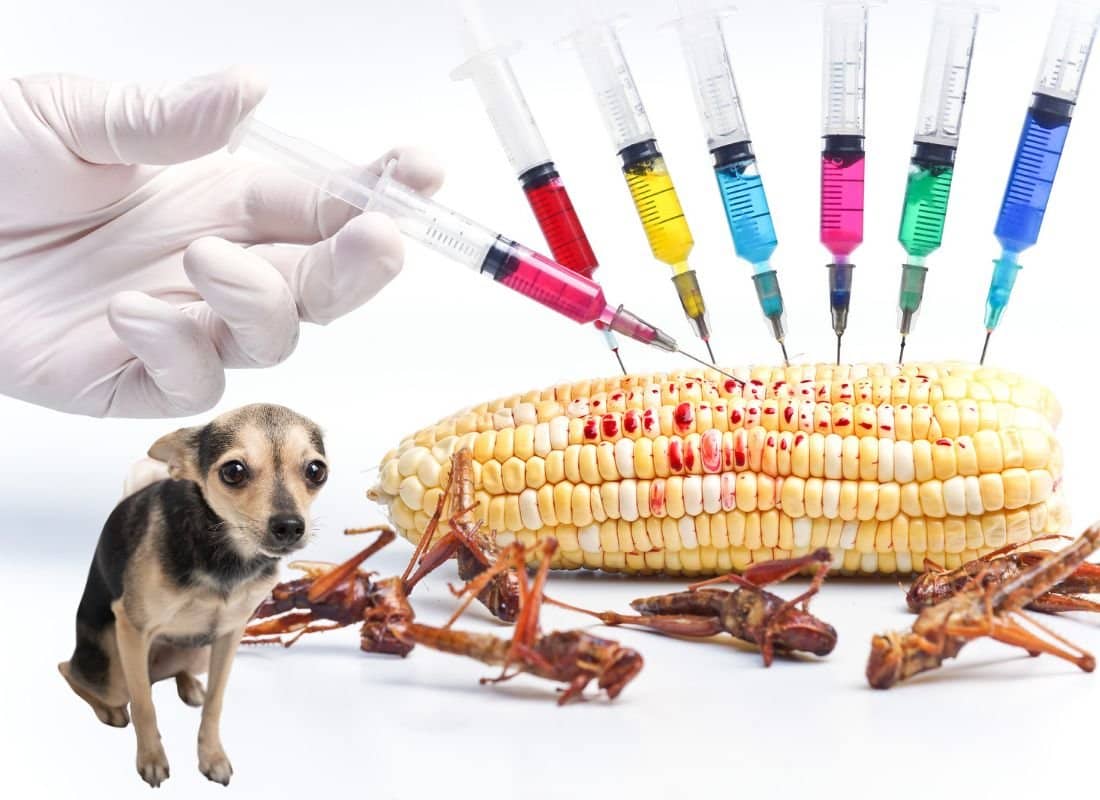How to Spot GMOs in Your Dog’s Food: A Complete Guide for Concerned Pet Parents

For pet parents concerned about GMOs (Genetically Modified Organisms) in their dog’s food, navigating pet food labels can feel like decoding a complex puzzle. We now know that GMO ingredients are harmful to humans and animals, so many pet owners prefer to make informed choices about what goes into their dog’s bowl, just the same as we want to know exactly what goes into our own food as well. Here’s your comprehensive guide to identifying GMO ingredients in pet food.
Understanding GMO Ingredients and Their Derivatives
First, it’s important to understand which ingredients are most likely to be genetically modified. In commercial pet food, the most common GMO ingredients are corn, soy, canola, cotton (used for cottonseed oil), sugar beets, and alfalfa. These ingredients often appear in different forms and under various names on pet food labels.
Common GMO derivatives include:
- Corn derivatives: corn meal, corn gluten, corn syrup, modified corn starch, corn oil, corn syrup solids
- Soy derivatives: soybean meal, soy flour, soy protein concentrate, soy lecithin, soy oil, tocopherols (Vitamin E from soy)
- Canola derivatives: canola oil, rapeseed oil
- Cotton derivatives: cottonseed oil, cottonseed meal
- Sugar beet derivatives: beet pulp, sugar, caramel color
- Synthetic vitamins often derived from GMO sources: Vitamin C (ascorbic acid), Vitamin E (tocopherols), Vitamin B2 (riboflavin), Vitamin B12
Trusted Non-GMO Brands and Products
Several pet food brands have committed to avoiding GMO ingredients. Although I am listing some of these brands below, you need to do your own due diligence and do research on these companies. Make sure they have no ingredients from rendering plants and check on the number of recalls they have had over the past few years. Be careful with any kibble because it’s seriously over-processed and have synthetic vitamins put in which are really dangerous to pets. Personally, I cook for our rescue dog, Mr Fitch, because I know exactly what is in each and every bite he eats. I also carefully choose his supplements so that they align with my preferences.
- The Honest Kitchen: Uses human-grade, non-GMO ingredients and carries the “Made with Non-GMO Ingredients” seal
- Castor & Pollux ORGANIX: Offers USDA organic certified pet foods
- Open Farm: Provides transparent sourcing and uses non-GMO ingredients
- Gathering Springs: Uses certified non-GMO ingredients and organic grains
- Stella & Chewy’s: Offers raw and freeze-dried options with non-GMO ingredients
Note: Brand offerings and formulations can change, so always verify current ingredients and certifications.
Understanding Organic Certification Standards
USDA Organic certification involves several key requirements:
- Ingredients must be grown without:
- Synthetic fertilizers
- Prohibited pesticides
- Sewage sludge
- GMO technology
- Ionizing radiation
- Certification Process:
- Annual on-site inspections
- Detailed record-keeping requirements
- Organic system plan maintenance
- Regular testing for prohibited substances
- Buffer zones between organic and conventional crops
- Organic Labels and Their Meanings:
- “100% Organic”: All ingredients are certified organic
- “Organic”: 95% or more organic ingredients
- “Made with Organic Ingredients”: At least 70% organic ingredients
Transitioning to Non-GMO Dog Food
A detailed transition schedule is below. It’s a typical transition schedule whenever your pet’s food is changed. Switching to non-GMO and organic is the best thing you can do:
Day 1-3:
- 75% current food
- 25% new non-GMO food
- Monitor stool consistency and energy levels
Day 4-6:
- 50% current food
- 50% new non-GMO food
- Watch for any digestive changes
Day 7-9:
- 25% current food
- 75% new non-GMO food
- Continue monitoring
Day 10:
- 100% new non-GMO food
Tips for a Successful Transition:
- Keep meal times consistent
- Maintain fresh, filtered water access
- Consider adding probiotics. We give Mr Fitch Four Leaf Rover supplements.
- Monitor your dog’s reaction
- Slow down if you notice loose stools. Adding organic canned pumpkin helps. I feed my dog, Mr Fitch, organic pumpkin twice a day.
- Consider digestive supplements if needed
Frequently Asked Questions
Q: Are GMOs dangerous for dogs? A: Although current scientific consensus indicates that approved GMO ingredients are safe for pet consumption, they are actually NOT and they are very damaging to their health. The choice to avoid GMOs is the best decision you can make as pet parents for your pets and for your human family as well.
Q: Why are some non-GMO dog foods so expensive? A: Non-GMO ingredients often cost more to source and verify. Additional testing, certification processes, and smaller production scales contribute to higher prices. That said, it’s worth it! Pay a little more or pay the veterinarian.
Q: Can I mix GMO and non-GMO dog foods? A: No! Just eliminate GMO sources completely.
Q: How can I be sure a product is truly GMO-free? A: Look for third-party verification like the Non-GMO Project Verified seal or USDA Organic certification. These provide the highest level of assurance.
Q: What if my dog has a sensitive stomach? A: Simply choose a limited-ingredient, non-GMO food for sensitive stomachs.
Additional Resources for Pet Parents
Consider joining online communities and resources dedicated to non-GMO pet food choices:
- Non-GMO Project’s Pet Food Database
- The Clean Label Project
- Pet Food Industry Association Guidelines
- Organic Pet Food Forums
- Local Holistic Veterinary Associations
The choice to avoid GMOs is a personal one, and it’s the right one!
Leave a Reply
You must be logged in to post a comment.
Leave a Comment